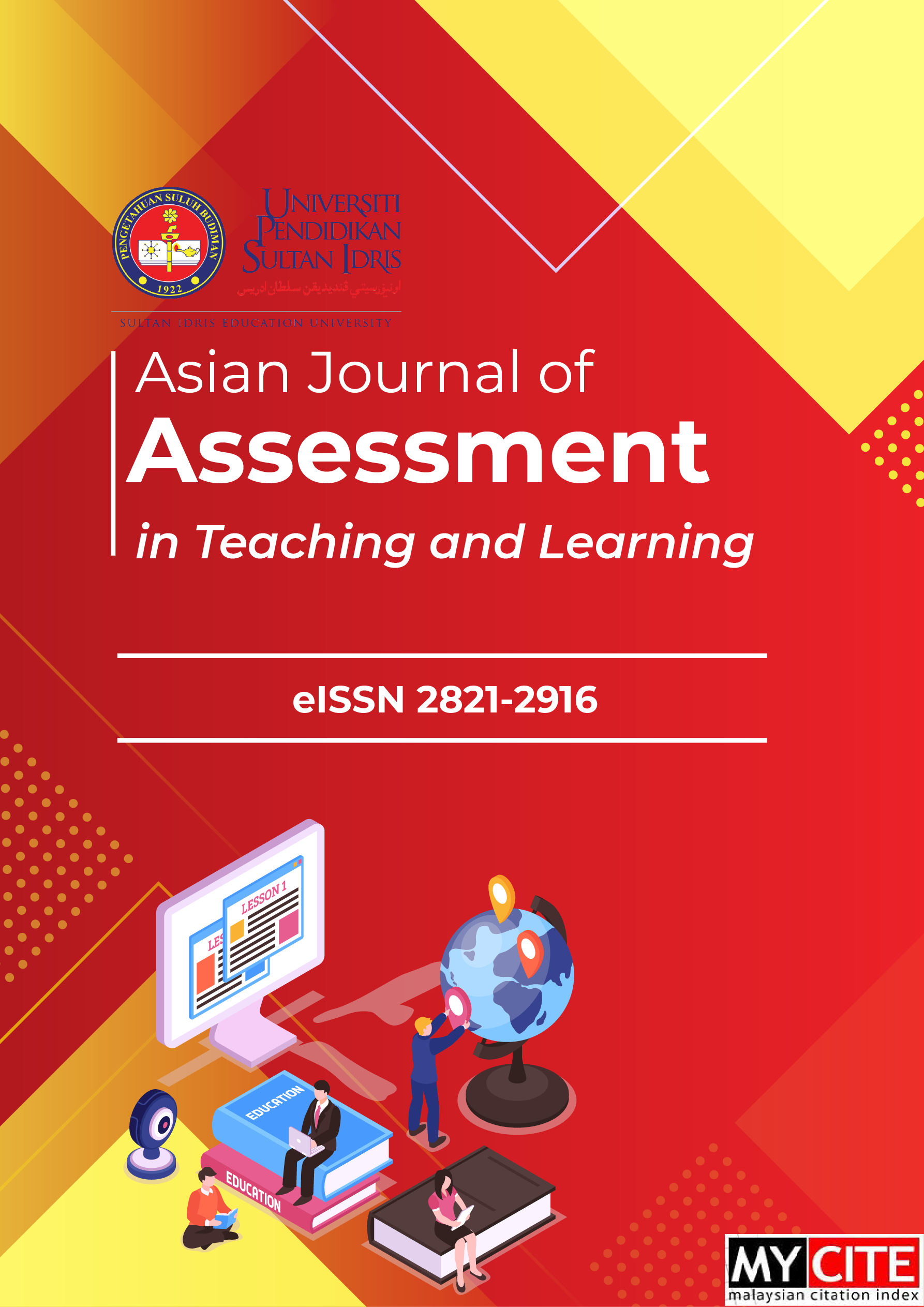Design of Hypothetical Learning Trajectory (HLT) in Mathematics using motif of Anyaman Bambu
DOI:
https://doi.org/10.37134/ajatel.vol9.no1.2.2019Keywords:
Anyaman Bambu, Design research, Hypothetical learning trajectory, Translation, AssessmentAbstract
Several previous researches showed that students had difficulty in understanding the concept of transformation. Students are more likely to be introduced by using formula, and their learning is separate from the daily experience of students. This underlies the researcher to design a learning trajectory of learning transformation and to connect it with experience-based activities. The purpose of this research is to design of hypothetical learning trajectory in learning translation using motif of Anyaman Bambu as a starting point or learning context. The method used in this research is design research with three-step that is preliminary design, design experiment, and retrospective analysis. The subjects in this research were several samples of student’s class VIII junior high school. The results of this research is the design of hypothetical learning trajectory in learning translation using the motif of Anyaman Bambu with a learning trajectory that is student drawing motif of Anyaman Bambu freely, student drawing motif of Anyaman Bambu with agreed conditions, student record the starting point and endpoint of the translation results in activities drawing the motif of Anyaman Bambu and finding the relationship between the two and finally, the student found the translation formula.
Downloads
References
Ada, Tuba, & Kurtulus, A. (2010). Students’ misconceptions and errors in transformation geometry. International Journal of Mathematical Education in Science and Technology, 41(7), 2010.
Arisetyawan, A., Suryadi, D., Herman, T., & Rahmat, C. (2014). Study of Ethnomathematics : A lesson from the Baduy Culture. International Journal of Education and Research, 2(10), 681–688.
Bakar, I.A.A., Kramer, O., Bordas, S., & Rabczuk, T. (2013). Optimization of elastic properties and weaving patterns of woven composites. Composite Structures, 100, 75–591.
Chahine, I.C. (2011). Beyond Eurocentrism: Situating Ethnomathematics Within the History of Mathematics Narrative. International Journal for Studies in Mathematics Education, 4(2), 35–48.
Christina, U., Ilukena, A., & Sindano, G. (2017). Exploring How Modern Sciences Impede the Development of Indigenous Knowledge (IK) [Ethno-science and Ethno-Mathematics] in the Kavango East Region: A Case Study. Journal for Studies in Humanities and Social Sciences, 6(2), 68–88.
Cobb, P., & Gravemeijer, K. (2006). Educational Design Research. Routledge, 29–63. https://doi.org/10.1016/j.ijbiomac.2013.09.048
Fouze, A. Q., & Amit, M. (2018). On the importance of an ethnomathematical curriculum in mathematics education. Eurasia Journal of Mathematics, Science and Technology Education, 14(2), 561–567. https://doi.org/10.12973/ejmste/76956
Haris, D., & Putri, R. I. I. (2011). The Role of Context in Third Graders ’ Learning of Area Measurement. Journal on Mathematics Education, 2(1), 55–66.
Heuvel-panhuizen, M.V.D., & Drijvers, P. (2014). Realistic mathematics education. Encyclopedia of Mathematics Education, 521–525. https://doi.org/10.1007/978-94-007-4978-8
Hollebrands, K.F. (2003). High school students ’ understandings of geometric transformations in the context of a technological environment. The Journal of Mathematical Behavior, 22(1), 55–72.
Lestariningsih, Putri, R.I.I., & Darmawijoyo. (2015). The Legend of Kemaro Island for Supporting Students in Learning Average. Journal on Mathematics Education, 3(2), 165–174.
Maryati, & Prahmana, R.C.I. (2019). Ethnomathematics : Exploration of the Muntuk Community. International Journal Of Scientific & Technology Research, 8(6), 47–49.
Mckenney, S., & Reeves, T. C. (2018). Conducting Educational Design Research. New York: Routledge.
Muhtadi, D., Sukirwan, Warsito, & Prahmana, R. C. I. (2017). Sundanese Ethnomathematics: Mathematical Activities in Estimating, Measuring, and Making Patterns. Journal on Mathematics Education, 8(2), 185–198.
Nasrullah, & Zulkardi. (2011). Building Counting by Traditional Game: A Mathematics Program for Young Children. Indonesian Mathematical Society Journal on Mathematics Education, 2(1), 41–54. Retrieved from http://search.proquest.com/docview/1773217206?accountid=8330
Ogunkunle, R.A., & George, N.R. (2015). Integrating Ethnomathematics Into Secondary School Mathematics Curriculum For Effective Artisan Creative Skill Development. European Scientific Journal, 11(3), 386–397. https://doi.org/10.1016/j.jsat.2007.03.006
Plomp, T. (2013). Educational Design Research: An Introduction. In Educational Design Research. Enschede: Netherlands Institute for Curriculum Development (SLO). https://doi.org/10.12968/bjon.2012.21.14.839
Prahmana, R.C.I., & Kusumah, Y.S. (2016). The Hypothetical Learning Trajectory on Research in Mathematics Education Using Research-Based Learning. Pedagogika, 123(3), 42–54.
Prahmana, R.C.I., Kusumah, Y.S., & Darhim. (2017). Didactic trajectory of research in mathematics education using research-based learning Didactic trajectory of research in mathematics education using research-based learning. Journal of Physics: Conference Series, 893(1), 012001.
Prahmana, R.C.I., Zulkardi, & Hartono, Y. (2012). Learning Multiplication Using Indonesian Traditional game in Third Grade Rully Charitas Indra Prahmana, Zulkardi, Yusuf Hartono. Journal on Mathematics Education, 3(2), 115–132.
Rosa, M., D’Ambrosio, U., Orey, D. C., Shirley, L., Alangui, W. V., Palhares, P., & Gavarrete, M. E. (2016). Current and Future Perspectives of Ethnomathematics as a Program. Switzerland: Springer. https://doi.org/10.1007/978-3-319-30120-4
Sembiring, R. K., Hadi, S., & Dolk, M. (2008). Reforming mathematics learning in Indonesian classrooms through RME. International Journal on Mathematics Education, 40(6), 927–939. https://doi.org/10.1007/s11858-008-0125-9
Stacey, K. (2011). The PISA View of Mathematical Literacy in Indonesia. Journal on Mathematics Education, 2(2), 95–126. https://doi.org/10.22342/jme.2.2.746.95-126
Downloads
Published
How to Cite
Issue
Section
License
Copyright (c) 2019 UPSI Press

This work is licensed under a Creative Commons Attribution-NonCommercial-ShareAlike 4.0 International License.





